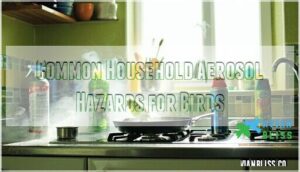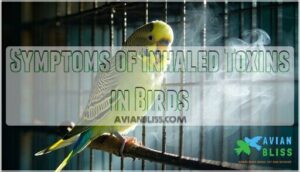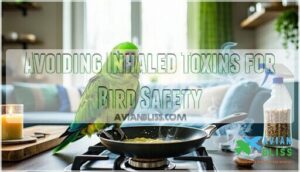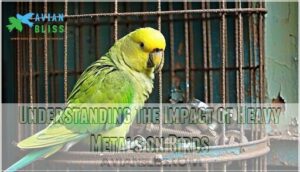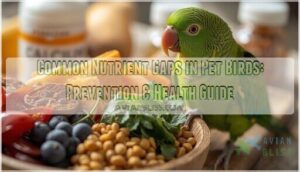This site is supported by our readers. We may earn a commission, at no cost to you, if you purchase through links.
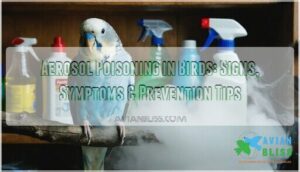
Common household items like Teflon cookware, cleaning sprays, and air fresheners can kill your feathered friend within minutes.
Birds don’t just breathe toxins into their lungs – their unique air sacs circulate these poisons throughout their entire body, which can lead to labored breathing, eye discharge, tremors, and sudden behavioral changes.
Even "bird-safe" products can be risky if used incorrectly, as the key isn’t avoiding all household products – it’s knowing which ones spell trouble and how your bird’s body processes airborne threats differently than yours.
Table Of Contents
- Key Takeaways
- Are Aerosols Toxic to Birds?
- Common Household Aerosol Hazards for Birds
- Signs of Aerosol Poisoning in Birds
- Symptoms of Inhaled Toxins in Birds
- Avoiding Inhaled Toxins for Bird Safety
- Understanding The Impact of Heavy Metals on Birds
- Identifying Signs of Heavy Metal Poisoning in Birds
- How to Create a Bird-Safe Environment
- Preventing Aerosol Poisoning in Birds
- Frequently Asked Questions (FAQs)
- How do birds get poisoned?
- Are aerosol sprays harmful to birds?
- What are the symptoms of chemical poisoning in birds?
- Are birds poisoning a common occurrence?
- How does lead toxicosis affect birds?
- How do you know if a bird is poisoned?
- Is aerosol toxic to birds?
- How do you tell if your bird has been poisoned?
- What is the most toxic thing to birds?
- What are the symptoms of bird fumes?
- Conclusion
Key Takeaways
- Your bird’s respiratory system makes aerosols deadly – Birds process airborne toxins more efficiently than humans, meaning household sprays, Teflon fumes, and cleaning products can kill within minutes of exposure.
- Watch for breathing changes and neurological symptoms – Look for labored breathing, open-beak gasping, tremors, eye discharge, and sudden lethargy as early warning signs that require immediate veterinary attention.
- Common household items are silent killers – Non-stick cookware at normal cooking temperatures, air fresheners, cleaning sprays, and even "bird-safe" products can release toxic fumes that overwhelm your bird’s delicate air sacs.
- Prevention beats treatment every time – Use stainless steel cookware, natural cleaning products, proper ventilation, and keep birds in separate rooms when using any aerosols to create a truly safe environment.
Are Aerosols Toxic to Birds?
Yes, aerosols can poison birds swiftly due to their unique respiratory systems. Birds process oxygen more efficiently than mammals, but this advantage becomes deadly when aerosol composition includes toxic particles.
A bird’s efficient breathing system becomes their deadly weakness around household aerosols
Your feathered friend’s bird sensitivity means even brief exposure duration to household sprays can trigger severe respiratory distress. Toxicity levels in common aerosols often exceed safe thresholds for birds.
What seems harmless to you—like air fresheners or cleaning sprays—can cause irreversible damage to delicate avian lung tissues. Teflon toxicosis from overheated cookware represents just one example of how quickly aerosol poisoning in birds occurs.
Understanding these bird health risks isn’t optional—it’s essential. Aerosol poisoning can progress from initial exposure to fatal outcomes within minutes, making prevention your best defense against tragedy.
Common Household Aerosol Hazards for Birds
Your home contains hidden threats that can turn deadly for your feathered companions. Common household aerosols pose serious risks because birds’ respiratory systems process airborne toxins differently than humans.
Teflon dangers top the list of household hazards. Non-stick cookware releases invisible, odorless fumes at normal cooking temperatures that can kill birds within minutes. Self-cleaning ovens and space heaters with fluoropolymer coatings create similar risks.
Cleaning fumes from everyday products pack a toxic punch:
- Bleach, ammonia, and bathroom cleaners produce vapors that damage delicate air sacs
- Window sprays and floor polishers release volatile organic compounds that accumulate in enclosed spaces.
Air fresheners and scented candles might smell pleasant, but they’re aerosolized substances waiting to harm your bird. Insecticides risks multiply during pest control, while paint toxicity from home improvement projects creates lingering airborne chemicals.
Even personal care items like hairspray and deodorants contribute to aerosol poisoning when used near bird areas. It’s essential to be aware of heavy metal toxicity from sources like paint and some toys. Additionally, it’s vital to recognize the importance of maintaining a safe environment for your birds.
Signs of Aerosol Poisoning in Birds
Recognizing aerosol poisoning in your feathered friend requires watching for telltale warning signs that something’s wrong. Breathing difficulty often appears first—you’ll notice your bird working harder to breathe, perhaps with an open beak or respiratory distress that’s clearly abnormal.
Eye discharge and nasal secretions signal exposure to aerosolized substances. Watch for lethargy onset—your normally active bird suddenly becomes quiet and withdrawn. Tremor severity can range from mild shaking to severe neurological symptoms, indicating serious Teflon toxicosis or other chemical exposure.
Don’t ignore sudden behavioral shifts like refusing to perch or fluffed feathers. Respiratory problems may include wheezing, coughing, or tail-bobbing while breathing. Unfortunately, acute death can occur rapidly with severe exposures, sometimes within minutes.
Time matters—if you spot these signs, immediately move your bird to fresh air and contact your veterinarian. Quick action can mean the difference between recovery and tragedy.
Symptoms of Inhaled Toxins in Birds
When your bird inhales toxic aerosols, you’ll notice specific symptoms that signal immediate danger to their respiratory and nervous systems.
These warning signs can progress rapidly from mild discomfort to life-threatening conditions, making quick recognition essential for your pet’s survival.
Respiratory Distress Signs
When aerosol poisoning strikes your bird, respiratory distress becomes the most telling sign.
Watch for these critical warning indicators:
- Labored breathing with visible chest movement and effort
- Open-mouth breathing instead of normal beak-closed respiration
- Tail bobbing that moves rhythmically with each breath
Wheezing sounds, nasal discharge, and other respiratory problems often accompany these symptoms.
Whether from Teflon toxicosis or other aerosolized substances, your bird’s respiratory system works overtime trying to process these harmful particles.
Consider that PTFE gas poisoning from overheated nonstick cookware can lead to acute death in small birds.
Think of it like trying to breathe through a straw – every breath becomes a struggle.
Don’t wait if you spot these signs.
Neurological Symptom Manifestations
Beyond breathing troubles, neurological symptoms reveal aerosol poisoning’s grip on your bird’s brain.
Tremor severity escalates from mild shaking to violent convulsions. Ataxia progression shows as stumbling, falling from perches, or inability to coordinate movements.
Seizure types range from brief episodes to sustained fits. Paralysis onset can occur rapidly, affecting wings or legs first.
Disorientation duration varies—some birds recover quickly while others remain confused for hours, unable to recognize familiar surroundings or respond normally.
Behavioral Changes Indicators
Watch your bird closely for behavioral red flags that signal aerosol poisoning dangers.
Sudden lethargy and reduced vocalization often appear first, followed by perching problems as toxic substances affect coordination.
You’ll spot fluffed plumage and agitation signs as neurological symptoms worsen from aerosol toxins.
Key warning behaviors include:
- Depression, excitability, and decreased responsiveness to familiar stimuli
- Staggering, falling from perches, and unusual head positioning
- Regurgitation or excessive wet droppings indicating systemic distress
Don’t dismiss these changes—your bird’s behavior tells the real story.
Avoiding Inhaled Toxins for Bird Safety
Protecting your bird from aerosol dangers starts with smart choices around your home. Think of your feathered friend’s respiratory system as a high-performance engine – it needs clean air to run smoothly.
Ventilation Importance can’t be overstated. Open windows safely when cooking or cleaning, but guarantee screens prevent escapes. Safe Alternatives include natural cleaning products instead of chemical sprays. Monitoring Air quality means watching for strong odors that signal trouble.
To improve air quality, consider using a dedicated air purifier.
Here’s your birdsafe checklist:
| Hazard Category | Items to Avoid | Bird Safety Measures |
|---|---|---|
| Cookware | Non-stick pans, heated Teflon | Use stainless steel, cast iron |
| Cleaning | Aerosol sprays, bleach | Choose bird-safe, natural cleaners |
| Air Care | Chemical fresheners, candles | Open windows, use air purifiers |
| Electronics | Exposed wires, overheating | Cord Safety through protective covers |
Toy Selection matters too – choose certified birdsafe materials. Remember, Household Hazards lurk everywhere, but Aerosol Poisoning Prevention becomes second nature with practice.
Understanding The Impact of Heavy Metals on Birds
While protecting your bird from airborne toxins matters, heavy metal contamination presents another serious threat.
These invisible dangers accumulate in your pet’s body over time, creating lasting health problems that can be harder to detect than aerosol poisoning.
Heavy metal sources include lead paint chips, galvanized wire cages, and contaminated water.
Your bird faces toxic substance exposure through everyday items you mightn’t suspect.
Metal toxicity levels build up gradually, making heavy metal toxicity particularly sneaky compared to acute aerosol poisoning.
Consider using a reliable heavy metal test to assess your bird’s exposure.
Here’s how bioaccumulation effects impact your feathered friend:
- Organ damage primarily targets kidneys and liver, where metals concentrate
- Lead levels above 15 ppm in liver tissue indicate serious poisoning risk
- Cadmium accumulation exceeds 2-8 ppm in kidneys of affected birds
Unlike respiratory distress from aerosols, heavy metals cause systemic problems.
Chelation therapy can help remove metals, but prevention works better.
Avian toxicity from metals affects behavior, reproduction, and immune function long before you’ll notice obvious symptoms.
Identifying Signs of Heavy Metal Poisoning in Birds
Recognizing heavy metal poisoning often starts with subtle changes you might easily overlook.
Your bird may develop tremors, seizures, or lose coordination as neurological symptoms emerge.
Watch for regurgitation, vomiting, and unusual dropping colors—especially pink or blood-tinged waste in parrots.
Feather abnormalities, appetite changes, and gradual weight loss signal organ damage progressing silently.
Unlike aerosol poisoning causing immediate respiratory distress requiring oxygen therapy, heavy metal toxicity develops slowly.
Birds experiencing these issues may require chelation therapy to remove toxic metals.
Blood testing and dropping analysis provide definitive diagnosis when avian toxicity is suspected.
Don’t mistake these signs for minor illness—early detection prevents irreversible damage.
How to Create a Bird-Safe Environment
Creating a fortress of safety for your feathered friend requires strategic planning and attention to detail. You’ll need to transform your home into a haven where toxic threats can’t reach your bird’s sensitive respiratory system.
- Use bird-safe cleaning products to avoid strong chemicals.
- Guarantee proper ventilation to remove airborne toxins.
- Choose safe toys made from non-toxic materials.
Ventilation strategies become your first line of defense against household poisoning hazards. Open windows, use exhaust fans, and consider air purifiers to keep fresh air circulating. Safe cleaning products replace harsh chemicals that trigger aerosol poisoning risks, while non-toxic toys eliminate hidden dangers from treated materials. Consider using specialized avian cleaners to guarantee a safe environment.
Monitor your environment regularly for bird health issues by checking for:
- Loose electrical cords that pose cord safety threats
- Overheated non-stick cookware releasing toxic fumes
- Aerosol products stored within your bird’s reach.
These avian care tips help you spot pet bird safety concerns before they become emergencies, creating peace of mind for responsible bird owners.
Preventing Aerosol Poisoning in Birds
Transform your home into a safe haven by implementing smart Ventilation Strategies that keep toxic fumes away from your feathered companion.
Keep birds in separate rooms when using household sprays, guaranteeing Aerosol Poisoning Risks stay minimal. Safe Cookware made from stainless steel or ceramic replaces dangerous non-stick surfaces that release deadly fumes.
Install Air Purifiers with HEPA filters to capture airborne particles and volatile compounds. Choose Product Alternatives like vinegar-water solutions instead of commercial cleaners.
Monitoring Environment becomes second nature when you regularly check for new hazards. These Avian Care Tips help birdproof your space effectively.
Position perches away from potential toxin sources, maintain emergency vet contacts, and keep travel cages ready. Fume Poisoning Prevention starts with awareness – even "bird-safe" products require careful evaluation.
Your vigilance guarantees Pet Bird Safety through consistent environmental management and proactive hazard elimination.
Frequently Asked Questions (FAQs)
How do birds get poisoned?
Birds get aerosol poisoning when they inhale toxic fumes from overheated Teflon cookware, cleaning products, paint, air fresheners, or smoke. Their sensitive respiratory systems can’t handle these chemicals.
Are aerosol sprays harmful to birds?
Yes, aerosol sprays are extremely harmful to birds.
You should never use air fresheners, cleaning products, or insecticides around your feathered friends—they can cause respiratory distress and death within minutes.
What are the symptoms of chemical poisoning in birds?
You’ll notice respiratory distress like labored breathing, wheezing, and open-beak gasping.
Watch for neurological signs including tremors, disorientation, and seizures.
Behavioral changes like sudden lethargy and reduced vocalization also indicate poisoning and can be marked by respiratory distress.
Are birds poisoning a common occurrence?
Like a canary in a coal mine warning of danger, household toxins silently threaten your feathered companions daily.
Bird poisoning isn’t rare—it’s surprisingly common due to their sensitive respiratory systems and everyday household products you mightn’t suspect.
How does lead toxicosis affect birds?
Lead poisoning devastates birds’ nervous systems, causing seizures, paralysis, and digestive issues. You’ll notice weakness, drooping wings, and green droppings. Without treatment, it’s often fatal within days.
How do you know if a bird is poisoned?
An ounce of prevention is worth a pound of cure," so watch for respiratory distress, tremors, lethargy, and unusual behavior.
You’ll notice labored breathing, eye discharge, disorientation, and sudden weakness—signs demanding immediate veterinary attention.
Is aerosol toxic to birds?
Yes, aerosols are highly toxic to birds.
You should avoid using spray cleaners, air fresheners, and non-stick cookware around them, as these can cause severe respiratory distress or sudden death within minutes.
How do you tell if your bird has been poisoned?
Watch for difficulty breathing, open-beak gasping, tremors, lethargy, eye discharge, and sudden behavioral changes. Birds often don’t show symptoms before fatal outcomes, so immediate veterinary attention is essential.
What is the most toxic thing to birds?
PTFE (Teflon) fumes from overheated non-stick cookware pose the deadliest threat to your bird. Even normal cooking temperatures around 464°F release toxic vapors that’ll kill birds within minutes of exposure.
What are the symptoms of bird fumes?
Bird fume symptoms hit fast and hard. You’ll notice labored breathing, open-beak gasping, and tail-bobbing. Tremors, disorientation, and sudden lethargy follow quickly, often progressing to collapse or death within minutes.
Conclusion
Protecting your bird from aerosol poisoning requires vigilance, knowledge, and proactive environmental management.
You’ve learned to recognize dangerous household products, identify early warning signs, and create safer living spaces for your feathered companion.
Remember that prevention beats treatment every time, and your bird’s unique respiratory system makes quick action essential.
By eliminating toxic aerosols, maintaining proper ventilation, and staying alert to symptoms, you’ll substantially reduce your pet’s risk of aerosol poisoning in birds while ensuring they live healthier, longer lives.
- https://www.petmd.com/bird/slideshows/10-home-dangers-pet-birds
- https://www.frontiersin.org/journals/veterinary-science/articles/10.3389/fvets.2025.1572736/full
- https://bestfriends.org/pet-care-resources/how-bird-proof-your-home-keep-pet-birds-safe
- https://birdsupplies.com/blogs/news/how-to-tell-if-your-bird-has-been-poisoned
- https://www.msdvetmanual.com/exotic-and-laboratory-animals/pet-birds/toxicoses-of-pet-birds

